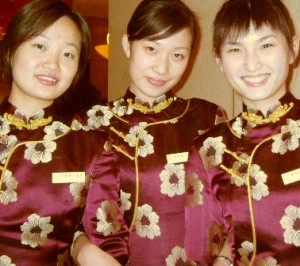
Beijing Hotel restaurant receptionists | Much To Enjoy in China
Before Olympics Games 
URING a two-week sojourn in the People’s Republic of China I spent a few fascinating days in the evolving capital. Although bustling Beijing is endowed with 3,000 years of enthralling history, it is an ultramodern metropolis vibrating with efficient subways, advanced telecommunications, gorgeous high-rises and expansive roadways. In anticipation of hosting Olympic Games 2008, the city fathers have embarked on an ambitious expansion of infrastructure with vast improvements in light rails, express highways, airports and other basic endeavors. 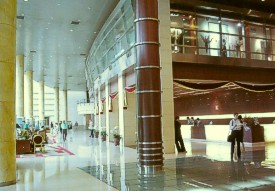
Beijing Hotel lobby is immense | While Beijing reportedly is the world’s fifth most expensive city, I found it to be a shopper’s paradise for the American tourist. With the dollar firmly pegged at 8.12 yuen, everything is downright inexpensive. I was impressed by the main avenues, which are so expansive, with four lanes in both directions. There are even separate lanes for bicycles. With a population of 14 million (8 million in the urban area), there are 8 million bikes and 2 million cars. Count ‘em for yourself. 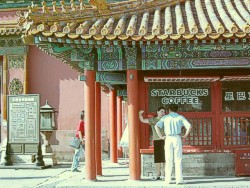
Inside the Forbidden City (What’s wrong
with this picture?) | Crossing the street can be life threatening even in constant gridlock. Sometimes you’ll sprint across a boulevard that stretches for eight lanes, four lanes in each direction. Traffic is wacky, with drivers careening in and out of lanes. In this country thousands are killed in traffic accidents every year. I witnessed a minor mishap involving a woman driver who collided with a male bicycle rider. She was screaming at the poor man for scratching her shiny new car. The ubiquitous fast food emporiums of KFC, Pizza Hut, Baskin Robbins, McDonald’s, Hard Rock Cafe and Starbucks add a touch of home for the western visitor. As for me, I’d welcome an outpost of the Second Avenue Deli (which alas vanished this year on the Lower East Side). 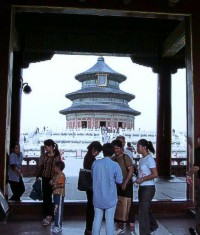
Hall of Prayer for Good Harvests in
the Forbidden City | Epicurean tourists will find their way to the well-known Hepingmen Quanjude Roast Duck Restaurant at 14 Qianmen West St., Tel. 6302 3062, www.chinaquanjude.com. Founded in 1979, it’s the largest roast duck eatery on the continent. With its 40 dining rooms, it can accommodate 1,300 diners at a time. Satisfied customers include former Secretary of State Henry Kissinger, former President George H.W. Bush and former UK Prime Minister Edward Heath. My room at the high-end Beijing Hotel had more than the usual amenities. In addition to the toiletries and hair dryer, there was an item I never encountered before: a gas mask in case of fire. This historic hotel is at 33 East Chang An Avenue, Tel. (86-10) 6513 7766, www.chinabeijinghotel.com.cn, located next to Tiananmen Square and the Forbidden City. Designated as the official host hotel of the 2008 Olympics, it has welcomed such distinguished guests as Chairman Mao, Dr. Sun Yat-Sen and Vietnam’s Ho Chi Minh. At the elaborate breakfast buffet, each item was named on a silver medallion—potatoes, hot cereal, eggs. The nametags on bacon, ham, pork and meat loaf carried a cautionary note: "Not for Moslems." 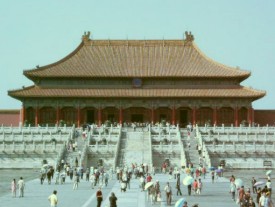
Hall of Supreme Harmony in the Forbidden City | You needn't fear walking anywhere in the city. People are in the main quite friendly and courteous. Van der Wal, who previously worked for the Inter-Continental in Rio de Janeiro, assured me, "Beijing is the safest place in China. You can go out on the street at three in the morning." Don’t miss an interesting sightseeing ride on a bicycle cab through one of the few remaining vestiges of Old Peking, the hutong. These old world densely populated neighborhoods, with ancient courtyard houses and open-air meat markets on winding alleyways, is a vestige of the past. Many of the hutongs, relics of the past, have been bulldozed to make way for modern gleaming high-rise apartments. The few that are preserved are a tourist attraction not to be missed. At a reception for foreign press, Ms. Xiong, deputy director general of the Beijing Municipal Bureau of Tourism, said that among the UNESCO World Heritages, 23 are in China, and of these six are in Beijing. Quite a record. 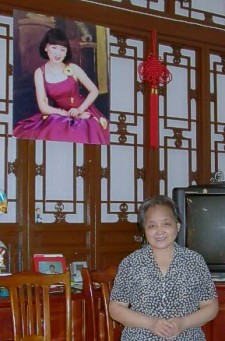
Retired accountant at home in hutong
with portrait of granddaughter | The Forbidden City , the 600-year-old bastion of mandarin authority, is awesome in its majesty. This city within a city, surrounded by a protective moat, served as the Royal Palace (Gugong) of 24 monarchs of two dynasties, from the early Ming in 1420 and to the fall of the Qing in 1911 when the Celestial Empire ceased. The imperial compound of 24 structures is undergoing extensive renovation to be completed in 2020, in time to celebrate its 600th anniversary. This walled area of 183 acres is a vast array of pavilions, halls and courtyards that make up an awe inspiring masterpiece of architecture. The grandeur is breath taking. Here is where Bernardo Bertolucci filmed his Oscar-winning The Last Emperor, depicting the departure of the fabled last emperor, Pu Yi, from the palace in 1924. I was culture-shocked to find that a Starbucks outlet had succeeded to invade the Forbidden City. I still can’t believe it. Tiananmen Square , ultimate symbol of the new China, is a spectacular concrete expanse of 98 acres, the size of 60 soccer fields and the largest public square in the world. It can easily accommodate half a million people. Built in 1417, it was the entrance gate to the Forbidden City. 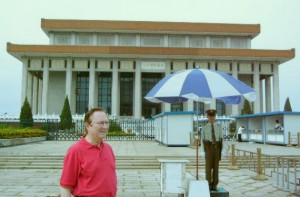
On Guard at Mao Mausoleum in Tiananmen Square | Several massive buildings rim the square, including Mao’s Mausoleum, Museum of the Revolution and Great Hall of the People. In China everything’s on a grand scale. I stood in the center of the square gazing at the Monument to the People’s Heroes, an obelisk dedicated to those who died for the revolution. Behind it is the two-tiered Chairman Mao Memorial Hall and Mausoleum, which strikingly resembles the Lincoln Memorial in Washington. The Temple of Heaven , built in 1420 and twice the size of the Forbidden City, is the site of sacrificial ceremonies at the winter solstice by the emperors of the Ming and Qing dynasties invoking divine intervention for plentiful rain and bountiful harvest. There are several temples in this magnificent complex, the main being the Hall of Prayer for Good Harvests, a round triple-roofed where sacrifices were made in the spring. Sacrificial rites in China go back thousands of years. 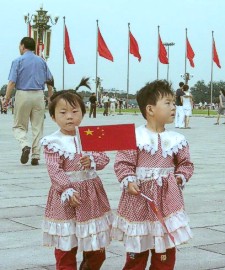
Youngsters in Tiananmen Square | Seen from above the temples are round, set on bases that are square, signifying ancient belief that heaven is round and the earth square. Everything is symbolic. The Great Wall is certainly a fascinating highlight of any visit to Beijing. Although it’s 2,000 years old, most of the masonry wall was built in the Ming Dynasty (1368-1644). The most visited section of the wall is at Badaling, 61 km north of Beijing. On the outskirts there’s a hotel, restaurants and the requisite souvenir shops. Don’t forget to buy a T-shirt: "I Climbed the Great Wall." (The hawkers won’t let you forget.) The China Great Wall Museum, in Badaling, is well worth a visit. On exhibit are weapons and other relics discovered in the vicinity. Next door is the Great Wall Circular Vision Theater showing a 15-minute film about the Wall’s history. 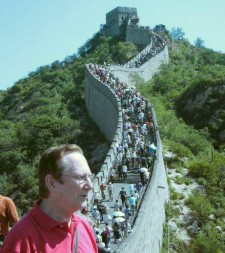
On the Great Wall of China | Kempinski Hotel Beijing Lufthansa Center is worth looking into even if you don’t check in. General Manager Marcus van der Wal arranged for a tour of his luxury property. Later I joined him as he hosted a lavish outdoor dinner at the Gong Palace for foreign visitors. The Gong Palace , former home of Prince Gong in the late 19th century, has a spacious garden and a pagoda that was used to gaze at the moon. I strolled through the lush garden to the large banquet hall, which is now a restaurant theater. I was thrilled by a performance of Peking Opera, acrobatics, sword dancing and kung fu. |